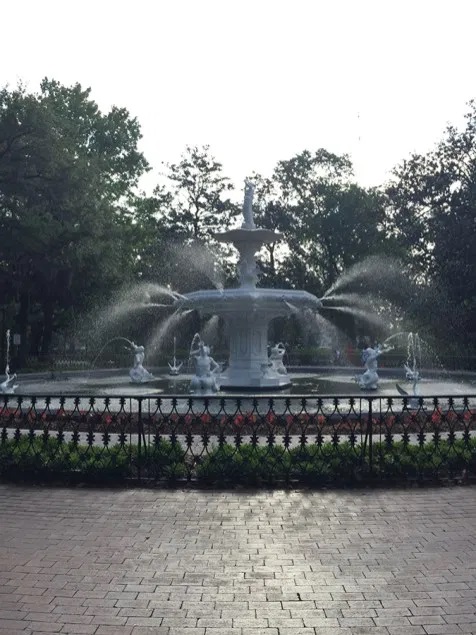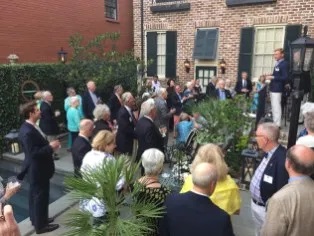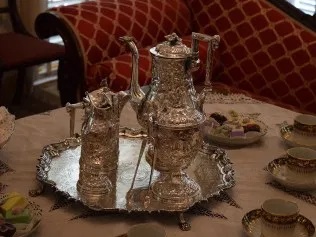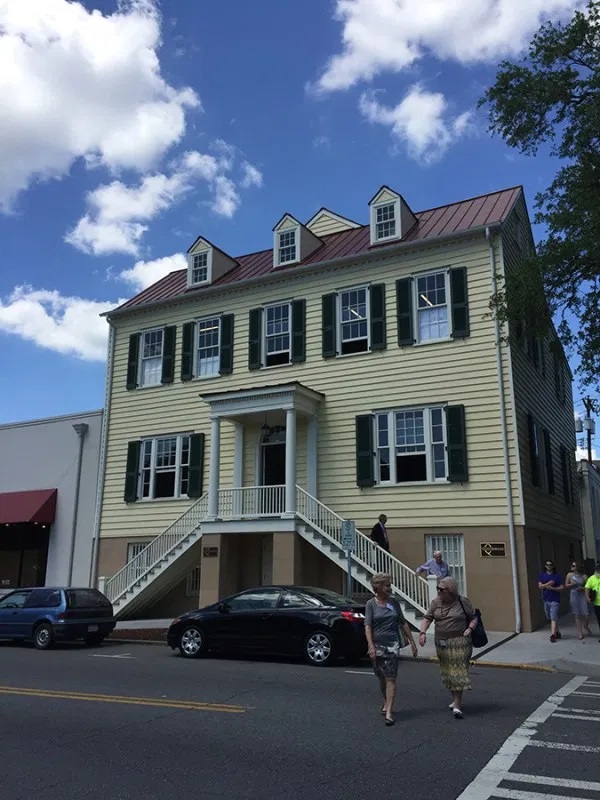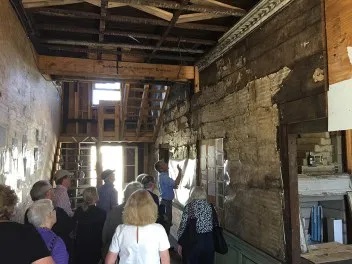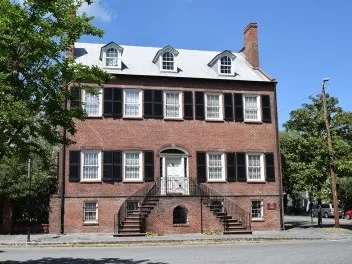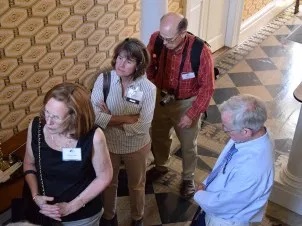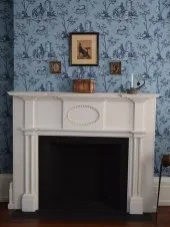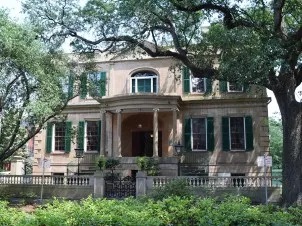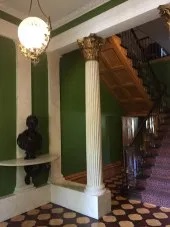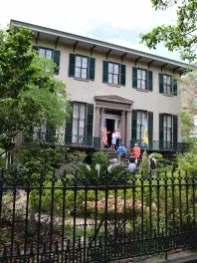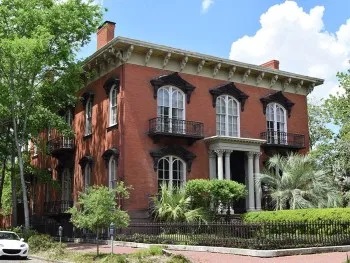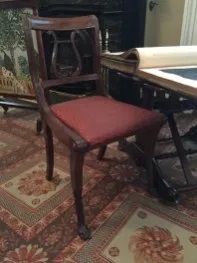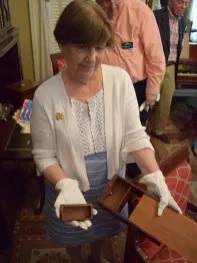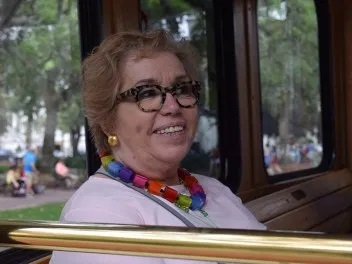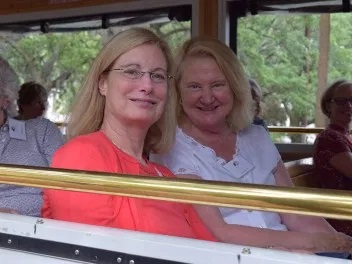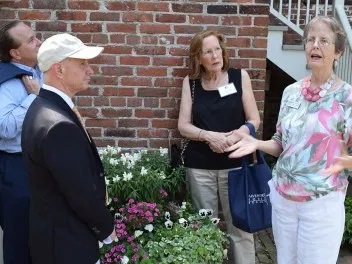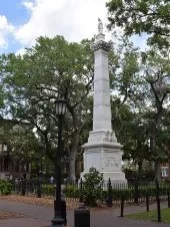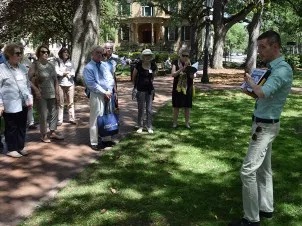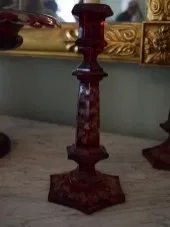Savannah: More than Meets the Eye

Founded in 1733 by British general and social reformer James Oglethorpe, the city of Savannah has remained an important center of commerce and culture ever since. Although it has long outgrown the original boundaries of Oglethorpe’s utopian grid plan, the city’s gorgeous historic center boasts an incredible array of historic structures. For those willing to delve a little deeper, Savannah readily offers up breath-taking collections, which contain fascinating histories amassed over nearly three centuries. For participants in the Trust’s Spring 2017 Symposium, Savannah was truly a city where there is more than meets the eye.
Dale Couch opens the symposium with his lecture “Evidence and Questions: an Overview of Early Georgia Decorative Arts.”
Our program opened with a wonderful lecture by Dale Couch, Curator of Decorative Arts at the Georgia Museum of Art, during which he pointed out that Georgia, and Savannah in particular, has always been current with the latest prevailing trends in style and taste. While many rich Savannah families imported household furnishings from northern manufactories or Europe during the 18th and 19th centuries, Georgia-made items possess a unique grace and style. Dale’s observations about a local taste for the trendy were fully borne out during the opening reception at the Green-Meldrim House. Built between 1853 and 1861, the lavishly detailed dwelling is one of the finest examples of Gothic-Revival architecture in the South. During the Civil War, Charles Green lent the house to Union General William Tecumseh Sherman for use as his headquarters. The Green family eventually left Savannah, but, in a stunning turn of events, much of their original furniture was recently discovered in the possession of descendants living in Paris and has returned to Savannah. During the reception, members enjoyed a brand new exhibit featuring highlights of the Green family furniture, curated by Tania Sammons, one of our speakers and a key figure on our symposium planning team.
Preservationist David Kelley shows participants surviving 18th century wallpaper fragments in the Berrien House.
Participants explore the Isaiah Davenport House. The wallpaper was reproduced from fragments found at the nearby Berrien House.
Our Friday schedule covered some of the oldest sites and earliest history of Savannah. Lecturers discussed a range of topics from Robin Williams’ exceptional talk on the development of the city’s urban plan to Jamie Credle’s introduction to the 20th-century preservation efforts started by a band of community-minded women. After lunch at the Olde Pink House, one of the city’s few surviving 18th-century structures, we enjoyed tours of three noteworthy sites. The John Berrien House, built by the Revolutionary War hero John Berrien in 1791, not only survived a devastating city-wide fire in 1820 but also managed to keep many of its original surfaces hidden away within the walls. Preservation architect David Kelley and historian Maryellen Higgenbotham discovered incredibly rare samples of original wallpaper dating back to the house’s earliest years. Just down the street, the Isaiah Davenport House tells a parallel story, interpreting the life of its namesake, a carpenter and joiner who built many fashionable structures throughout Savannah in the early 19th century, including his own showcase house. The Davenport house was the first success of the city’s preservation movement, which formalized under the auspices of the Historic Savannah Foundation. In the six decades since, the wildly successful organization has gone on to save hundreds of buildings throughout the city. Our final stop was the fabulous Owens-Thomas House, built 1816-1819 by the fashionable young English architect William Jay in the latest Regency style. The house is one of three sites run by the Telfair Museums and exhibits graceful 19th-century furniture in a beautifully restored interior. The legendary Southern hospitality evident throughout the house extended into the rear garden, where participants enjoyed the chance to rest their feet and relish a scoop (or two!) of Savannah’s famous Leopold’s ice cream.
Saturday turned our focus to Savannah’s architectural heyday during the mid-19th century, when wealthy families commissioned the grand Victorian mansions that became a fixture of the city’s image. Sometimes the figures associated with the buildings rise above their local roles. The Andrew Low house, for instance, was the birthplace of Juliette Gordon Low, the founder of the Girl Scouts, and is now a pilgrimage site for girls in green sashes as well as the history-minded visitors who appreciate the sterling collection on view there. No visit to Savannah would be complete, however, without a visit to the Mercer House. Construction for the family of General Hugh Mercer was interrupted by the Civil War, which prevented any member of the family from ever living there. After a century of various owners, the house experienced a golden age during the 1970s, when it was restored by preservationist and antiquarian Jim Williams. Both the house and Williams sprang to national prominence upon the publication of Midnight in the Garden of Good and Evil in 1994, and the release of the feature film three years later. However, the house tells a larger story of the city and the development of the American antiques trade, as Williams was a collector, dealer, and decorative arts scholar in his own right. Much of his collection remains in the house today, and we were greeted by Williams’s sister, Dr. Dorothy Williams Kingery, the current owner. Our final stop was across the street at the home and gallery of local artist Morgan Kuhn. Her loving restoration of a Monterey Square townhouse, which had long been subdivided into apartments, not only returned a fine historic structure to its original glory but exhibits Savannahians’ unabated emphasis on historic preservation.
Our symposium concluded with four compelling lectures on Sunday morning. Rita and Daniel Elliott of the LAMAR Institute related their findings on regional pottery, with a particular focus on Purysburg, SC, just across the border. Historian Kathleen Staples examined the history behind a family quilt long thought to depict a scene from the Civil War but actually dating from the American Revolution. Jenny Garwood of MESDA discussed samplers made by two Low Country girls, Mary Smallwood and Sarah Jones, which featured the Ten Commandments. Our closing lecture by Shannon Browning-Mulliss, Curator of History and Decorative Arts at the Telfair Museum, closed with an important reminder of the importance of using the decorative arts to tell stories of the forgotten figures of history, in this case the enslaved Driver Morris, who received an engraved silver cup from his master in recognition of his bravery during a disastrous storm.
For the Trust, this symposium was a fresh look at a city well known to many. Thanks to the gracious help of local Trust member, and the newest addition to our Board of Governors, Mary Raines, Tania Sammons, and our wonderful hosts and speakers, we enjoyed unprecedented access to the delights of the city, some well known and others known only to locals, complemented by Savannah’s legendary hospitality. We look forward to more adventures in the second half of the year, particularly our 40th anniversary celebration in conjunction with the Fall Symposium in Hartford!
About The Decorative Arts Trust Bulletin
Formerly known as the "blog,” the Bulletin features new research and scholarship, travelogues, book reviews, and museum and gallery exhibitions. The Bulletin complements The Magazine of the Decorative Arts Trust, our biannual members publication.








